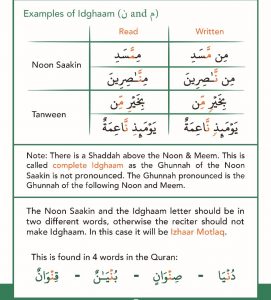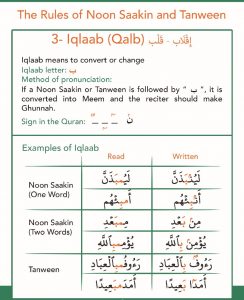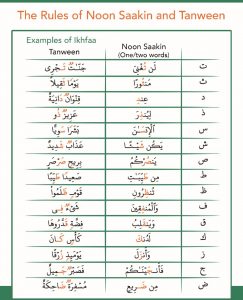Tajweed linguistically derives from the goodness of a thing, tajweed, meaning to do something good, or improving, where it is said that something is good, i.e. its good, and it becomes good. It is worth it, and to recite in an elaborate manner free from poor pronunciation.
It is worth noting that God Almighty has commanded the recitation of the Noble Qur’an, as the Almighty said: {And recite the Qur’an with recitation}, and when Ali bin Abi Talib was asked – may God be pleased with him – about the meaning of recitation in the verse The generous said: “Intonation: intonation of letters and knowledge of standing.” This article will discuss the Rules of Learning Tajweed Online
Rules of learning Tajweed for beginners
The rulings on Tajweed are divided into many types, and their explanation is as follows:
-
Table of Contents
ToggleRulings on seeking refuge with Allah and basmalah:
seeking refuge is a recommended Sunnah, and it is required when reciting the Book of God – the Most High – even though it is not from it, and some of them argued that it is obligatory, especially at the beginning of The recitation, whether the beginning of the recitation is from the beginning of the surah or the end of it.
The evidence is the saying of the Most High: (So when you recite the Qur’an, seek refuge with God from the accursed Satan). As the basmalah; it is saying “In the name of God, the Most Gracious, the Most Merciful.” It must be read by Imam Hafs at the beginning of every surah except for Surat al-Tawbah.
-
Rules of the Noon Saakin and tanween:
the noon نون ساكنة (consonant) or tanween in the case of nominative, accusative, and preposition has four rulings, which are as follows:
- Idgham إدغام
is defined in language: as the insertion of a thing into a thing. An aggravated letter like the second, and the tongue rises when it is brought up by one, and the nun static or tanween is mixed in if one of the following letters falls after it: ya, ra, mim, lam, waw, and nun. Complete, God – the Most High – said in Surat Al-Baqarah: (or as a part of it).

You can see our lesson here
- Al-eqlap (AlQalb) إقلاب- قلب
the inversion in the language comes with the meaning of turning something from its face. It is the baa, and it comes in a word, such as the saying of God Almighty: (It grows), and it comes in two words, such as the Almighty’s saying: (Hearing, Seeing).

- Al-ezhaar الإظهار
The manifestation is defined linguistically as the statement, and what is technically meant is the manifestation of the nun consonant or tanween at one of the throat letters that come after the nun consonant or tanween, and the vowels are six: the hamza, the ha’, the eye, the ha’, the ghain, and the kha’. They are called the halaq letters, so the nun sakina or the tanween are pronounced without a chant while showing the letter that follows them independently of them.

- Ikhfaa:
Ikhfaa linguistically: to conceal, but idiomatically: it is the pronunciation of an unstressed consonant, and it is an adjective between manifestation and dwarfism, with the chant remaining in the first letter by two movements, and its letters are: s’ad, thaal, tha’a, jim, shin, and qaf. And the sein, the kaf, the dad, the za’, the zai, the ta’, the signifier, the ta’, the fa’, and the example of which is the Almighty’s saying: (عن صلاتهم).

You can see our lesson on youtube
-
Rules of the meme:
The Saakin meme (static) has three rulings, which are as follows:
- Oral diphthong: It is that the consonant meme in a meme is mixed in a vowel like it located at the beginning of the second word, so they become one stressed meme, and it is called an oral or symmetrical meme, taking into account the full pronunciation of the chants.
- Oral concealment: The meem is hidden if it occurs at the beginning of the word after the letter ba.
- Oral manifestation: It is the manifestation of the meem if any letter of the alphabet occurs after it except the meem and the ba, and it is more pronounced with the waw and the fa.
-
The aggravated meem and noon Rules:
The aggravated meme and nun are obligatory in the case of wasl and endowment, and whether it occurs in the middle or at the end of a word, and the extent of the meme is two movements.
You can get free lesson here
Rulings of immersion: It is the insertion of a consonant letter with a vowel after it, by deleting the consonant and emphasizing the vowel, and it is divided into three types, which are as follows:
- Matching combinations: It is that the two consecutive letters are united in the exit from the mouth, and are united in the adjective as well, whether they occur in one word or in two successive words.
- Mixing of homogeneous: It is that the two successive letters are united in the exit from the mouth, and differ in some characteristics, and this is limited to seven letters, namely: taa with taa, taa with ta, dal with ta, taa with dal, dal with da’, and ba with meem .
- Idgham Al-Muqaqarebin: It is the convergence of the two successive letters in the expression and the adjective, and it is limited to two letters, namely: Lam with Ra, and Qaf with Kaf.
-
Rulings on Tajweed and makhareg elhorof:
taqweem linguistically means fattening and thickening, and idiomatically: it is a state of strength and obesity that affects the letter when pronouncing it, so the mouth is filled with its echo.
You can read more about: Best Ways To Teach your kids Quran | Get to know 8
Rulings and characteristics of the letters’ makhraj: the number of letter makhrajat is seventeen, and the origins of the mukharij
are traced back to five main makhrajat, which are: the hollow, the throat, the tongue, the lips, and the gills. These are: whispering, loudness, softness, intensity, between looseness and severity, arrogance, superiority, openness, occlusion, whispering, deafness, whistling, turbulence, elongation, softness, elongation, deviation, pervasiveness, and repetition.
- The Rules of endowment and initiation:
The Rules of endowment and initiation are divided into two parts, and they are as follows:
- Endowment: linguistically; Imprisonment and abstinence, as technically: it cuts off the sound from reciting for a short period of time to breathe in it and then re-read, and the endowment is permissible unless there is something preventing it or obligating the endowment, and it is in the middle of the verses or at their heads, and it is not in the middle of the word, nor in what is connected to a drawing, and sections The endowment is four, and it is the emergency endowment: which is what is presented to the reader during his reading of sneezing, coughing, or shortness of breath, and it is a permissible endowment. Test endowment: It is the endowment that is in the place of education, and is for clarifying rulings, or answering a question.
- The waiting endowment: It is the endowment in which the reader wants to collect more than one narration from the readings. Voluntary endowment: It is for the reader to stop at the Qur’anic word of his own free will, and without incident, and it is either a complete, sufficient, good, or ugly endowment.
- The initiation: is known as the Initiation of the beginning of the recitation, and the initiation comes in two types, namely: a permissible type at the beginning of the recitation: it is a good beginning with an independent speech, so that it leads to a complete meaning that God Almighty willed. An impermissible type at the beginning of the reading: It is an ugly beginning with words that corrupt the meaning, and change it without what God Almighty wanted.
you can read more about: How to learn Quran online from home?| best 4 steps
Learning Tajweed online
The scholars of Tajweed went to the fact that the ruling on learning the rules of Tajweed is an obligation of sufficiency; That is, if someone performs it enough, the sin will fall on the rest.
As for the rule of applying its Rules while reading the Qur’an, it is an individual obligation, and for this reason Imam Ibn Al-Jazari, may God have mercy on him, says: And there is no dispute about it that the Islamic nation is required to understand the meanings of the Noble Qur’an, reflect on its verses, and establish the limits that it imposed.
It is also called upon to correct the pronunciation of the letters of the Qur’an and to establish them in the form transmitted to us through the imams of the readings connected to the Prophet, may God bless him and grant him peace, in the eloquent Arabic language, which is not permissible to contradict, nor to deviate from it to something else. He reads it without pretense or arbitrariness, and it is easy and kind to read.




